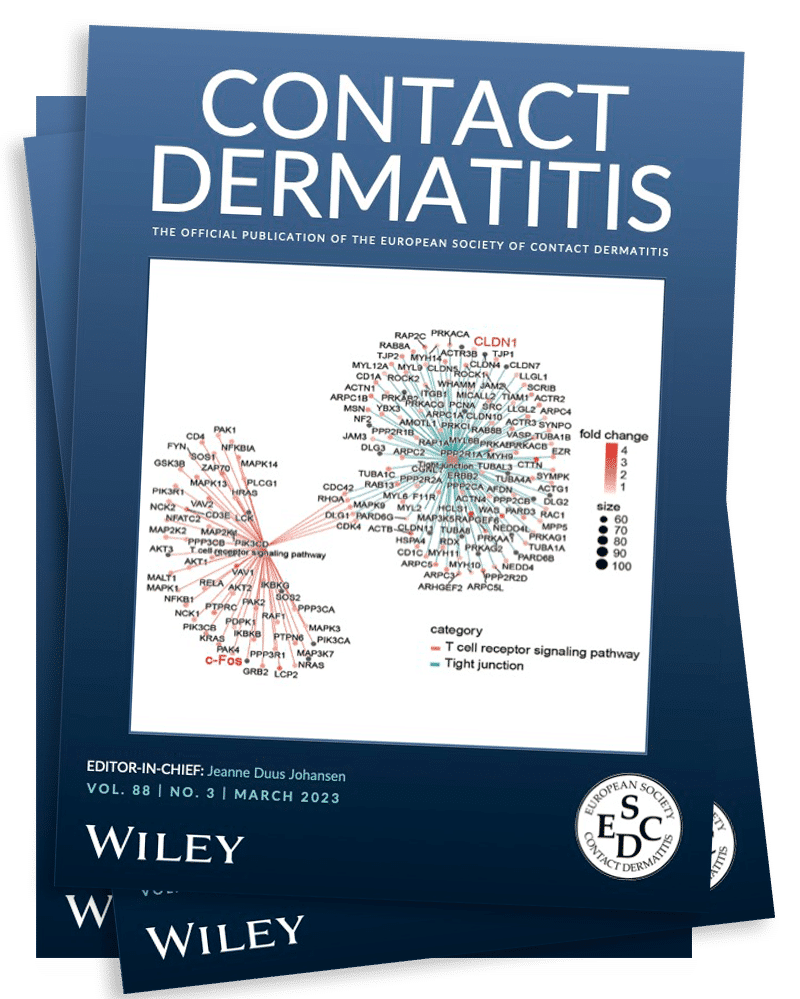Welcome to our website
Are you in doubt about a diagnosis, the choice of an allergen or just curious?
Then ask your colleagues
…to guidelines, master classes, reference books, the journal Contact Dermatitis and participate in task forces influencing policies in Europe.
The European Society of Contact Dermatitis (ESCD) is the leading source of expertise, in the field of cutaneous allergy, environmental and occupational dermatitis.
Recommendations of the European
Society of Contact Dermatitis
many open access in:
Contact Dermatitis
Patch Testing 5th Edition
The full text of Anton de Groot’s well-known book Patch Testing (5th edition, 2022) is available to all members of the Society. A big thank you from The Executive Committee goes out to Dr de Groot for his generous donation of the book.

The Journal Contact Dermatitis is the official journal of the ESCD. It publishes scientific discoveries in the field of cutaneous allergy, environmental and occupational dermatitis, including chemical aspects, immunology, and drug reactions. Its impact factor is (2021):6.4
(free for members)


The ESCD promotes interest in contact dermatitis and environmental & occupational skin diseases
Dr Mihály (“Misi”) Matura
secretary@escd.org
💡 New publication alert: Sensitisation to the acrylate co-polymers glyceryl acrylate/acrylic acid co-polymer, sodium polyacrylate and acrylates/C10-30 alkyl acrylate cross-polymer (Carbopol®) is rare
🔬 A BSCA audit (September 2021–2022) across 20 patch test centres in the UK and Ireland assessed sensitisation to three acrylate co-polymers in 1302 patients.
🔎 The results showed minimal reactions: one doubtful, one irritant to glyceryl acrylate/acrylic acid co-polymer; four irritant, one doubtful, one 1+ to sodium polyacrylate; none to Carbopol®.
Find the full text here: doi.org/10.1111/cod.14679
#science #allergy #research #dermatitis ... See MoreSee Less
Sensitisation to the acrylate co‐polymers glyceryl acrylate/acrylic acid co‐polymer, sodium polyacrylate and acrylates/C10‐30 alkyl acrylate cross‐polymer (Carbopol®) is rare
doi.org
A BSCA audit (September 2021–2022) across 20 patch test centres in the UK and Ireland assessed sensitisation to three acrylate co-polymers in 1302 patients. The results showed minimal reactions: one...💡 New publication alert: Hand eczema in Italian patients referred for patch testing: A retrospective SIDAPA study (2016–2023)
🔬 One thousand five hundred and ninety-seven consecutive patients with HE (961 with exclusive hand localisation) underwent patch testing from 2016 to 2023 in eight Italian dermatology clinics.
🔎 ACD, ICD and atopic HE were documented in 48.1%, 47.5% and 7.1%, respectively; hyperkeratotic palmar, acute recurrent vesicular and nummular clinical subtypes in 52.2%, 43.9% and 11.9%, respectively.
Find the full text here: doi.org/10.1111/cod.14684
#science #dermatitis #allergy #research ... See MoreSee Less
Hand eczema in Italian patients referred for patch testing: A retrospective SIDAPA study (2016–2023)
doi.org
One thousand five hundred and ninety-seven consecutive patients with HE (961 with exclusive hand localisation) underwent patch testing from 2016 to 2023 in eight Italian dermatology clinics. ACD, ICD....💡Publication alert!
🧐 Read about four cases of contact allergy to Dalbergia spp woods related to exposures from playing musical instruments and woodwork hobbies (doi.org/10.1111/cod.14668)! ... See MoreSee Less
👍 Thanks to everyone who attended this year's 16th ESCD Congress in sunny Dresden!
🙃 Missed out? Join us in Dublin in 2026! ... See MoreSee Less
Only one week left until we meet at the ESCD Congress 2024 in Dresden.
We’re looking forward to many highlights in the scientific program and the amazing networking opportunities.
Have you registered yet? If not, use your chance – registrations are still open at escd2024.com/reg/ ... See MoreSee Less
💡Contact allergy to metals and complications following arthroplasty - a complicated area where definitive clinical guidance is lacking. Read more about a case report where revision of a hip replacement containing titanium in a patient with titanium contact allergy resulted in remission of a new-onset erythroderma in a 58 year old man:
... See MoreSee Less
Titanium allergy to a hip implant presenting with a generalised rash and keratoderma
doi.org
Click on the article title to read more.💡Are chromium and cobalt detectable in leather goods tanned in the EU? Read more below 👇
Work by Jensen et al. (doi.org/10.1111/cod.14643) has shown that chromium is detectable in 77 of 87 (83.9%) leather samples provided by manufacturers, while cobalt is detectable in 52 of 87 (59.7%) samples.
🧐These findings confirm that chromate is still used widely as part of the leather tanning process, while the detection of cobalt suggests that tanned leather products may be an important source of contact allergy to cobalt and that further regulation of its use may be required. ... See MoreSee Less
💡Publication alert!
Patch tests in non-immediate cutaneous adverse drug reactions: Late readings on Day 4 is more sensitive than on Day 3 by Matei et al.
🧐 This retrospective, single-centre study suggests that patch test readings on day 4, as opposed to day 3, can increase patch test positivity to a suspected drug from 13.7% to 24.9% in patients with non-immediate cutaneous adverse drug reactions.
Read more at the link below 👇 ... See MoreSee Less
Patch tests in non‐immediate cutaneous adverse drug reactions: Late readings on Day 4 is more sensitive than on Day 3
doi.org
Our study shows that a second reading at D4 (24.9%) enchances the sensitivity of a first reading at D3 (13.7%) for the patients' positivity of PTs with suspect drugs in the exploration of NICADR (p ...🤓Want to hear more about contact allergy?
😎Join us at the ESCD Congress in beautiful Dresden!
escd2024.com ... See MoreSee Less